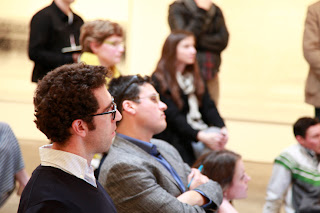rethinking my artistic identity-bingjie li
the experiences brought by New York is totally different from the LA trip. I feel the metropolises like a container with different people and identities from all over the world. i would concentrate on the rethinking of identity. as an international student I am very interested in the forming of identity and how it chan
ged with the surroundings. honestly speaking I was a little bit confused with my own identity before, as I got a diverse background while people easily categorize you simply with one of your characteristics or features. but the talk at ICI, the visits to Asia Society and MOCA, acting as inspiring elements, offer me an opportunity to rethink the issue of identity, and my own formation of identity. let's say the exhibition of Sarah Sze, some piece of hers totally tells her oriental identity but some of her works is hard to tell the artist's background and history, the universe one about day and night. personally it is almost impossible to find a clue telling her Chinese side.
identity shown what you have got through in the past. i would like to discourse my artistic identity here. As a design student, the most thrilling and attractive part definitely is the Guggenheim. the beautiful elegant spiral started ranging art since 1956. decades did not change the meaning of the design. I felt extremely excited there and my friend was a little bit confused about my status. this interesting reaction made me think about identity in a deeper extent. people tend to think the world in the perspective based on their own background and their experiences. for example we are faced the same task, i would be intended to think a long run meanwhile she would easily hind herself focussed on the presenting moment. i never consider this in a way relat
ed to identity, but I just took it for granted that because we got different personalities. then what about explaining this phenomenon from the aspect of identity? before I came to SFAI, I got a four-year study in field of design. Design aims at solving problems and offering people a more comfortable and cozy experience of living. it means a designer, or who is supposed to be a designer, must have a keen eye on what is the same drawback in different individual
experiences. take the ramen spoon i saw in the MoMA gift shop as an illustration, its designer had great and detailed observation of people's eating ramen. S/he concentrated on the behavior itself, it doesn't matter who is the one eating ramen, or when is the time that ramen been eaten. the ramen spoon combing a fork and a spoon in a clever way solve the problem of having them at the same time. gaining trainings for several years to form the logic behind the ramen spoon, I easily pay attention to the issues in daily life which are also everlasting, such as human natures and emotions.
Meanwhile, my friend had a background in mass media before she came here for the graduate program in SFAI. Mass media requires people to be sensitive of the presenting issues right this moment, probably it is the reason that she usually gets inspiration from news or the ongoing issues for her art work.
this phenomenon is pretty interesting, and my discourse sounds making sense in some way. for me the greatest thought from the new york trip is about identity. every thing happens for reasons. every piece tells the artist's hidden part of identity.














































